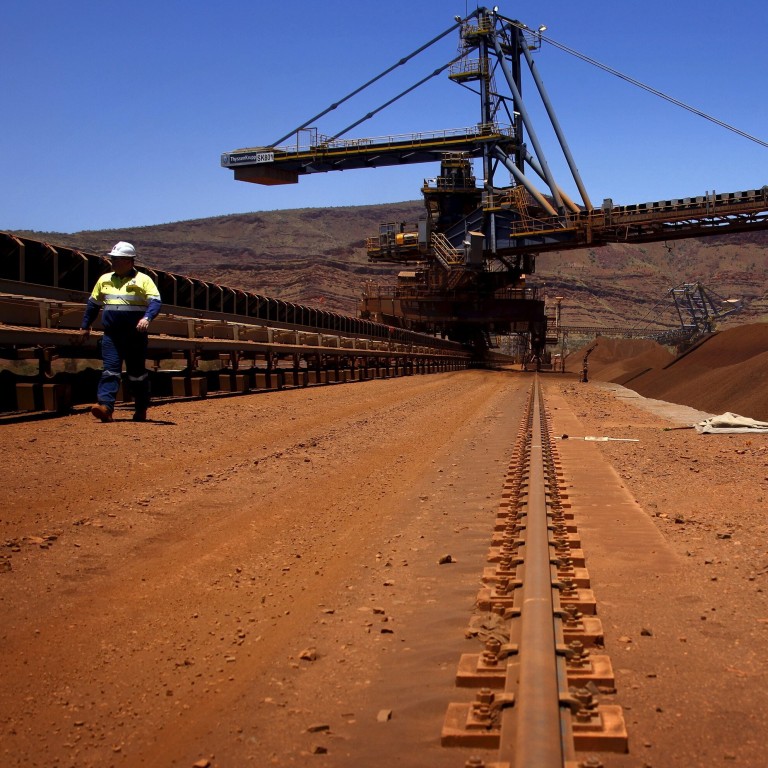
China-Australia trade: iron ore miner Fortescue set earnings, shipment records in past financial year
- Since prices hit an all-time high of more than US$230 a tonne in May, prices for the steelmaking ingredient have fallen with Chinese authorities curbing output
- Beijing blocked several goods amid its protracted geopolitical conflict with Canberra, but iron ore shipments are still welcomed with open arms
China’s ravenous appetite for iron ore has helped Australian miner Fortescue double its profits and achieve record shipments while making Australian shareholders and governments wealthier with a bumper dividend and royalty payouts.
In its 2020-21 financial year results released on Monday, Fortescue said it had more than doubled its net profits to US$10.3 billion and unveiled total dividends of about US$8 billion.
The miner, which ships almost all of its iron ore to China, said it reached its “highest-ever annual shipments of 182.2 million tonnes” of iron ore and achieved “earnings and operating cash flow surpassing any year in its history”.
In late July, during Fortescue’s April-June quarter production update, CEO Elizabeth Gaines warned that it was monitoring the Chinese market closely as steel margins and prices had been volatile, adding that there was “policy uncertainty relating to production curtailments”.
While China and Australia have one of the Asia-Pacific region’s most envied trade partnerships – valued at more than A$250 billion (US$183 billion) a year, according to Australian trade figures – the two have been locked in a geopolitical conflict for more than 16 months.
But iron ore, which accounts for about a third of the total trade value, has been spared any trade disruptions, as evidenced by the strong results of Australian mining companies in the current 2020-21 financial year reporting season.
Navigate Commodities managing director Atilla Widnell said on Monday that he was expecting more tightening in China’s steel and iron ore sector following investigations into “hoarding and speculation” in iron ore markets, government crackdowns on onshore physical iron ore traders, and more steel-export quotas or tariffs prompting steel mills to cut output.
On Monday, China’s biggest listed steel producer, Baoshan Iron & Steel (Baosteel), also confirmed that it was expecting cost pressures to ease on the back of government-mandated steel production cuts, and that it was expecting a reversal in iron ore prices and demand as a result.
“The company has always stuck to a low-inventory strategy. As the country is carrying out policies to restrict crude steel output, the supply and demand of iron ore have reversed significantly,” Baosteel Chairman Zou Jixin said in an online briefing.
Zou also said iron ore prices have entered a downward channel.
Affected by the curbs, Baosteel said it would adjust production, strengthen its raw-material purchasing strategy and work to maintain relatively good profitability.
The company also said it had reduced exports of steel products in line with government policy changes.
Another sign of slowing Chinese steel production and cooling iron ore prices came 10 days ago when a merger between China’s Anshan Iron & Steel and Benxi Iron & Steel finally materialised – a move that will sharpen the steel sector’s influence in negotiating prices of raw material such iron ore, according to S&P Global Platts.
Also reaffirming a slowdown in steel output, S&P Global Platts’ steel-manufacturing production index for China hit a five-month low in July.
“Lower steel output was driven mostly by China’s increasing efforts to cut steel output amid seasonal power shortages,” S&P Global Platts said in a note.
“China has been aiming to lower steel production in 2021 from 2020 levels. The government in July asked steel mills to start curbing output – a measure that market sources said was aimed at controlling rising iron ore prices.”
Additional reporting by Reuters

